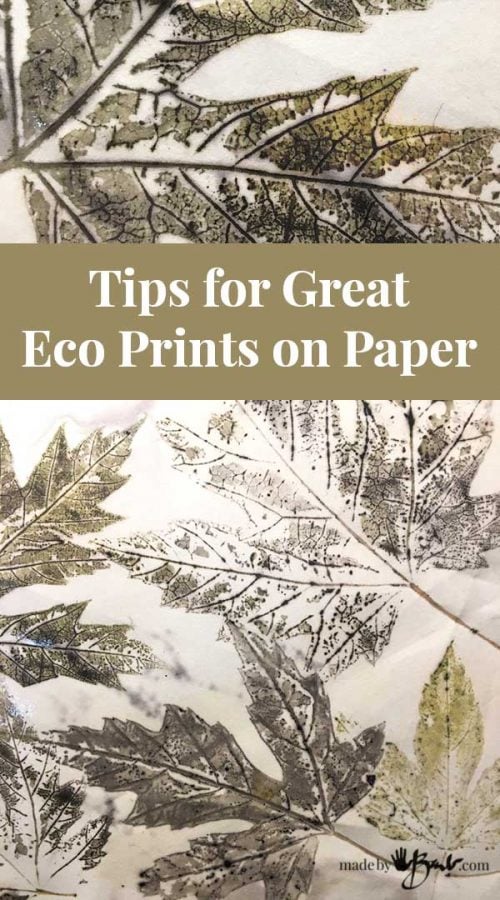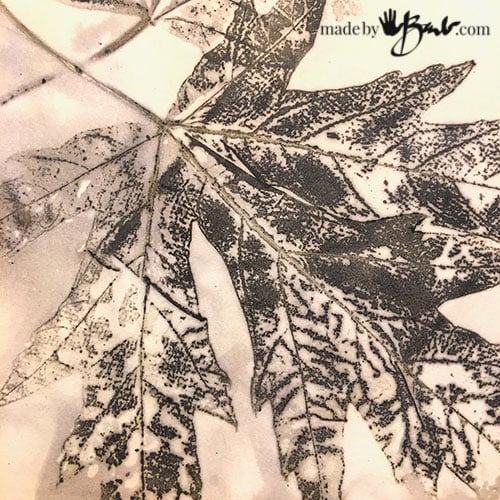Tips for Great Eco Prints on Paper

Nature just drops amazing stuff at our feet all the time! Did you know that beautiful prints emerge from those leaves laying on the ground?! Rather than raking, let’s learn some tips for Great Eco Prints on Paper.

How Easy:
As you may know I am a bit obsessed with Eco printing. Where can you make something so pretty with just found windfall? Recently when unrolling some bundles I hated to throw away the leaves as they looked well enough to be able to print again.
Paper is relatively inexpensive so perfect to test eco printing on. I often use the regular card stock from the office supply store. I have a simple no-fuss system to print on paper using my microwave that I use often because it does not involve a lot of time.

A quick slip through some alum and iron sulphate solution to wet the paper and then stack with my favourite printing leaves. TIP: I try not to have the paper too saturated especially if it is cheaper paper.

Great prints involve the reaction of the tannins and iron. If in doubt then an extra reassurance is the addition of some tannin rich tea or natural dye. TIP: Myrobalan is always a great performer as well as any of the readily available black teas. Be creative and let the magic happen… A little squirt lets the ‘tea’ find it’s way through the stack around the leaves & gives great results.

What if?
Maybe, just maybe the print is not quite to your liking; so it can still be saved. ‘Not to mention the awesome texture the leaves imprint into the paper like some high-end custom embossing!
Don’t despair; iron to the rescue.

Iron Modifier:
Basic principle; iron + Tannin = print. TIP: Mix a touch of iron sulphate into some warm water and selectively paint it onto the sections that are not as defined as you’d like.

Lovely greens and subtle design… but I’d like more punch.

It is quite a magic to watch it change as you paint on the iron solution, right before your eyes. Such chemistry.

Iron is called a modifier, not a mordant. It will help the prints along, and ‘sadden’ them. This means they will become darker but also less saturated in colour; more brown/black/grey.

TIP: If paper is not super saturated/wetted it will give more defined prints. It will also be much easier to keep flat. The amount of veins that print is mind-boggling!

A little addition of iron and voila; such definition.


TIP: The underside (where veins are visible) is the side that will print the best/darkest as the cells have thinner shells.

You have the control to decide where to darken. TIP: If you have a print that is too dark you can lighten the dark iron with some citric acid (like lemon juice) Which incidentally will also clean your fingers of the iron stains. Just cut a lemon and stick your finger tips in it (you’re welcome!)

TIP: When stacking the papers put leaves between each sheet. Then when unwrapping you will have prints on both sides and can choose which side is better.

TIP: Reuse leaves. I’m quite amazed that these were prints from leaves used once before!


Wonderful detail on simple cheap card stock. If you were patient you could print ‘One of a kind’ business cards…

TIP: Iron is great but also be aware it will also stain, but it is a lovely golden ochre colour. (bring on rust-printing…) Over time iron can degrade the fibre. These great Eco prints on paper are made into cards so I am not that worried.
Gather, print and Enjoy!
Hi Barbara
I appreciate your wonderful articles on eco dying and printing so much! I live in North Carolina and I was wondering if I could ask my daughter to gather some leaves for me in New Jersey and save them for me to use when I can get up there for a visit and can get them. I don’t know how she should keep them or preserve them so they would be usable later. The tree leaves down here go straight to brown. I really miss the many varieties of fall leaves up north. I’ve printed with flowers and flower leaves in the summer but we have mostly live oaks down here. Any suggestions for saving “Northern” leaves would be so appreciated. Thank you for your wonderful articles!
Eileen
The leaves can be saved: see this post. I do it in the fall. If it is within a week I keep them in plastic bags in the fridge.
Hey , can we use iron rust instead of iron sulphate ??
Yes, at the beginning I did use rusty things to make the ‘rusty water’. It worked great, the only thing is it’s hard to gauge the strength. But for keeping it simple, it’s a great inexpensive way to start. Happy printing!
hi barb,
Thank you very much for your sharing, it really helped me a lot. may I want you something, can you share eco-print on leather?
Hello, Barb,
You are, indeed, a master craftsman.
Will eco-prints like this fade when exposed to strong sunlight? What might make them less / or more permanent? If I use lemon juice on parts of it, will those parts become even lighter over time? Will the surface of the paper remain perfectly flat or does the steaming buckle it? If I need to iron it flat, would ironing damage or change the print. (Thinking about ironing – have you ever used this general process by “steam ironing” it. Would that ruin my iron?) nv
That’s a lot of questions! You may want to take a curse with an Eco printer! I think everything fades in sunlight! So these would be no exception. Using the proper mordant, good plant material and procedure will help keep them permanent. Don’t use fugitive food colours. I bet the lemon juice would lose potency and also evaporate so I don’t think so. I tend to make as an artist , less as a scientist. The steaming with the iron doesn’t hurt the print unless you scorch it as the process already involved heat. Just steam ironing does not make a decent print but there are some who use some steam appliances… microwave is fine for me. Good luck!
I have just learned about eco printing. It’s early spring in Minnesota. If I gather leaves now that fell in the fall, will they still work, or do I have to wait until summer/fall?
You can dry leaves and they still work as long as they have good amount of tannins. (like dried teas still works) See this post for storing hints. I have a good stock pile for use during winter… Happy printing!
How do you dispose of your rust water from eco printing? Thank you!
You can dispose diluted around the garden…